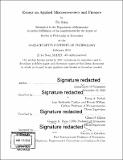| dc.contributor.advisor | Parag A. Pathak and Glenn D. Ellison. | en_US |
| dc.contributor.author | Song, Fei,Ph. D.Massachusetts Institute of Technology. | en_US |
| dc.contributor.other | Massachusetts Institute of Technology. Department of Economics. | en_US |
| dc.date.accessioned | 2019-07-18T20:29:01Z | |
| dc.date.available | 2019-07-18T20:29:01Z | |
| dc.date.copyright | 2019 | en_US |
| dc.date.issued | 2019 | en_US |
| dc.identifier.uri | https://hdl.handle.net/1721.1/121786 | |
| dc.description | Thesis: Ph. D., Massachusetts Institute of Technology, Department of Economics, 2019 | en_US |
| dc.description | Cataloged from PDF version of thesis. | en_US |
| dc.description | Includes bibliographical references (pages 255-262). | en_US |
| dc.description.abstract | This dissertation consists of four chapters. Chapter 1 studies the effect of online review manipulations on review systems. Chapter 2 and Chapter 3 are co-authored with Ali Kakhbod and focus on post-trade transparency in dynamic over-the-counter markets. Chapter 4 is co-authored with Umut Dur, Parag A. Pathak and Tayfun Sönmez and studies the effect of the Taiwan mechanism, a mechanism that allocates high school seats to applicants. Chapter 1 shows that the conventional impression holds in the short-run that review manipulation makes review systems less informative. In the long-run, however., a manipulated review system can contain the same level of information as an un-manipulated counterpart. I develop a dynamic programming model with fixed product quality and naive buyers who are unaware of manipulation. I then extend it to consider endogenous product quality and sophisticated buyers. I also identify an unexpected effect of a policy to target sellers and check for manipulation. | en_US |
| dc.description.abstract | Chapter 2 studies how mandatory transparency (through TRACE), along with the long-term incentive of informed dealers, affects market price informativeness, liquidity and welfare in dynamic over-the-counter (OTC) markets. We show that the public disclosure of additional information about past trades, paradoxically, makes the markets more opaque, by reducing the market price informativeness. Thus, surprisingly, transparency requirements such as U.S. Dodd-Frank Act may make markets more opaque. However, this market opacity creates liquidity and increases welfare. To enhance financial transparency and improve the price informativeness as well as the market liquidity and welfare, an effective approach is to randomly audit dealers. Chapter 3 then studies how public disclosure of past trade details affects price discovery dynamics under asymmetric information with heterogenous hedging motives. | en_US |
| dc.description.abstract | We model that an informed buyer (informed trader) sequentially trades with a series of uninformed sellers (hedgers). The informed buyer is forward-looking and risk-neutral, and uninformed sellers are myopic and heterogeneously risk-averse. We discover that sellers' price discovery over the underlying fundamentals is crucially affected by what they can observe about past trade details. Specifically, (i) post-trade price transparency delays price discovery, but once it happens, it is always perfect. (ii) In contrast, when only past order information is available, price discovery can never be perfect, and can even be in the wrong direction. (iii) The availability of past trade details, paradoxically, makes it easier for the informed buyer to hide her private information and offer opaque prices. We establish that, under some minor regularity conditions, our equilibrium characterization achieves the maximal degree of ignorance among all pure-strategy PBE. | en_US |
| dc.description.abstract | Hence, this chapter can be viewed as a worst case analysis for regulators who care about market transparency. Moreover, we show that our findings are robust when the informed party's bargaining power decreases along the length of past trade history. Finally, we extend our results to the case where the informed buyer has a non-zero outside option, and the case where both parties switch their trading positions. Chapter 4 analyzes the properties of the Taiwan mechanism, used for high school placement nationwide starting in 2014. In the Taiwan mechanism, points are deducted from an applicant's score with larger penalties for lower ranked choices. Deduction makes the mechanism a new hybrid between the well-known Boston and deferred acceptance mechanisms. Our analysis sheds light on why Taiwan's new mechanism has led to massive nationwide demonstrations and why it nonetheless still remains in use. | en_US |
| dc.description.statementofresponsibility | by Fei Song. | en_US |
| dc.format.extent | 262 pages | en_US |
| dc.language.iso | eng | en_US |
| dc.publisher | Massachusetts Institute of Technology | en_US |
| dc.rights | MIT theses are protected by copyright. They may be viewed, downloaded, or printed from this source but further reproduction or distribution in any format is prohibited without written permission. | en_US |
| dc.rights.uri | http://dspace.mit.edu/handle/1721.1/7582 | en_US |
| dc.subject | Economics. | en_US |
| dc.title | Essays on applied mircoeconomics and finance | en_US |
| dc.type | Thesis | en_US |
| dc.description.degree | Ph. D. | en_US |
| dc.contributor.department | Massachusetts Institute of Technology. Department of Economics | en_US |
| dc.identifier.oclc | 1103441645 | en_US |
| dc.description.collection | Ph.D. Massachusetts Institute of Technology, Department of Economics | en_US |
| dspace.imported | 2019-07-18T20:28:58Z | en_US |
| mit.thesis.degree | Doctoral | en_US |
| mit.thesis.department | Econ | en_US |
